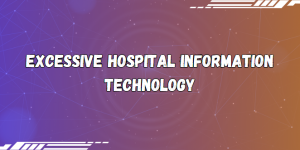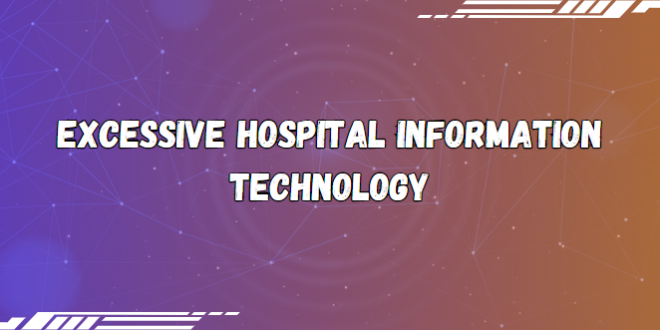In today’s digital age, hospital information technology (IT) plays a vital role in healthcare systems. While technology has brought numerous advancements and benefits to the medical field, there are instances where excessive reliance on hospital IT can become a challenge. In this article, we will explore the concept of excessive hospital information technology and its potential impact on healthcare delivery.
The Rise of Hospital Information Technology

Over the years, hospitals and healthcare organizations have embraced various forms of information technology to streamline processes, improve patient care, and enhance efficiency. Electronic health records (EHRs), telemedicine, computerized physician order entry (CPOE) systems, and digital imaging are just a few examples of the technology that has become commonplace in healthcare settings.
The Pros of Hospital Information Technology
There are several advantages to implementing hospital information technology. EHRs, for instance, allow for seamless documentation, easy access to patient records, and improved care coordination. Telemedicine enables remote consultations and expands access to healthcare services, particularly in underserved areas. Digital imaging provides faster and more accurate diagnoses, leading to better patient outcomes.
Potential Challenges of Excessive Hospital Information Technology
While hospital IT offers significant benefits, there are potential challenges associated with its excessive use:
1. Information Overload
With the increasing amount of data generated by hospital IT systems, healthcare providers may face information overload. Sorting through excessive information can be time-consuming and may distract from providing direct patient care.
2. Increased Administrative Burden
Hospital IT systems require significant administrative tasks, such as data entry, system maintenance, and troubleshooting. Healthcare providers may find themselves spending more time on administrative duties rather than focusing on patient care.
3. Technology Dependency
Excessive reliance on hospital IT can lead to a dependency on technology. In the event of system failures or technical glitches, healthcare providers may struggle to deliver care efficiently, potentially impacting patient safety.
4. Staff Training and Competency
Implementing new hospital IT systems often requires training and ongoing support for healthcare staff. Excessive technological changes can strain resources and lead to difficulties in ensuring staff competency and comfort with the new systems.
5. Patient-Provider Relationship
Excessive use of hospital IT may result in reduced face-to-face interaction between patients and healthcare providers. Building trust and establishing a strong patient-provider relationship can be challenging when technology becomes the primary means of communication.
Strategies to Mitigate Excessive Hospital Information Technology
To address the challenges posed by excessive hospital information technology, healthcare organizations can consider the following strategies:
1. Streamline IT Systems
Organizations can assess and streamline their IT systems to eliminate redundant or unnecessary processes. This helps reduce the burden on healthcare providers and improves efficiency.
2. Enhance Training and Support
Investing in comprehensive training programs and ongoing support for healthcare staff can ensure their competence and comfort with hospital IT systems. This reduces frustration and improves the overall user experience.
3. Foster a Balanced Approach
While technology is essential, it’s crucial to strike a balance between the use of hospital IT and direct patient care. Healthcare providers should be encouraged to allocate time for meaningful patient interactions alongside technological tasks.
4. Engage Patients in the Process
Involve patients in their care and decision-making processes, ensuring that they understand and have access to their health information. This helps maintain a patient-centered approach despite the increased reliance on technology.
Conclusion
Excessive hospital information technology presents both opportunities and challenges in healthcare delivery. While technology has the potential to revolutionize patient care, it’s important to strike a balance and mitigate the potential downsides. By streamlining IT systems, enhancing training and support, fostering a balanced approach, and engaging patients, healthcare organizations can navigate the complexities of excessive hospital information technology and provide high-quality care. Remember, technology should be a tool that enhances the patient-provider relationship, not replaces it.
Stay Tuned for More Exciting Articles
Thank you for reading this article about excessive hospital information technology. We hope you found it informative and thought-provoking. Stay tuned for more exciting articles in the future. Goodbye, and see you in our next captivating piece!
 Spacetimes A collection of the latest news and information from various trusted sources
Spacetimes A collection of the latest news and information from various trusted sources
